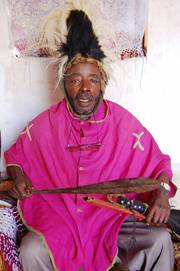|
"Men of the Blood" Come Clean
IRIN
December 11, 2009
Kenya

Traditional circumcisers like Maingi are determined to remain relevant
Every December, the village of Kangete, in eastern Kenya's Nyambene District, gears up for yet another season of festivities - not Christmas, however, but the initiation of hundreds of young men into manhood through circumcision.
"I will wear my mungi [Colobus monkey headgear], a flowing red gown and red shoes to match - red symbolizes blood and I am a man of the blood," Alfonze Maingi, a 63-year-old traditional circumciser told IRIN/PlusNews. Maingi, a well-respected figure in the community, has had 30 years’ experience in the business.
Kenya has officially adopted medical male circumcision as part of its national HIV prevention strategy, but among Nyambene's ethnic Meru community, a traditional circumciser, or mutani, is still the preferred choice. The historical symbolism of the ritual, which takes place with much pomp and ceremony and is followed by weeks of seclusion during which initiates are taught the meaning of manhood, is more significant than the outpatient hospital procedure.
Boys whose parents choose hospital are looked upon as weak and cowardly. "We are encouraging hospital circumcision but [medical] facilities are not adequate and culture has forced most boys to turn to the traditional circumcisers," said Francis Baariu, the district AIDS and sexually transmitted infection control officer.
And men like Maingi - who is grooming two of his sons to follow in his footsteps - are determined to remain relevant: "I come from a clan of circumcisers and must pass on the baton in the family for our tradition to continue."
A 2007 study found a link between unhygienic circumcision and HIV infection among non-sexually active adolescents in Kenya. Another study suggested that the practice in certain Kenyan cultures of encouraging young men to have sex before their circumcision wounds are fully healed could put them at a heightened risk of HIV.
Another study, conducted in western Kenya in 2006, found a higher rate of complications among men circumcised traditionally compared with the clinical route. The authors warned that as male circumcision became widely promoted for health reasons, "new opportunities for traditional and unqualified practitioners will emerge", putting more men at risk of botched procedures.
The solution would be to make traditional circumcision safer, so the health ministry has started a programme to train traditional circumcisers in basic hygiene, suturing and the safe disposal of their tools.
Merging tradition with modern realities
The health ministry is also encouraging a blending of medical and traditional circumcision, where boys are allocated a special room in a medical facility so that under the eye of qualified health personnel, traditional practitioners can perform the cut. Upon healing, initiates join the cultural seclusion.
"The idea is to make male circumcision safe while it remains as traditional as possible," said Michael Kariuki, the medical officer of Health for Nyambene District Hospital. "We have received a positive response and this is happening at the mission health centres and dispensaries."
In 2008, 60 male circumcisers - both traditional and medical - were trained in male circumcision and provided with a “safe circumcision” kit.
Maingi is among the traditional circumcisers who have benefited from the training. In the past, he used a single sharpened knife for several men every day during circumcision season, but today, he wears gloves, uses a single surgical blade for each boy and administers an antiseptic and a painkiller afterwards.
"I too must be cautious and observe health precautions to protect myself and the initiates; this is to avoid the risk of HIV transmission," he said.
He is an expert in two types of circumcision - the total removal of the foreskin, known locally as kithoiri, and the partial removal or ndii, which is traditionally practised by the Meru community, but which is losing popularity.
"Nowadays, most parents prefer the total removal of the foreskin which is the easy job for me," Maingi added. "They do not want the ndii, it is complicated and they say it has no value."
This trend is in line with a recent Ugandan study that found the risk of HIV infection to be higher among men with larger foreskin surface areas.
According to the Kenya AIDS Indicator Survey 2007, 85 percent of men are circumcised; most men undergo circumcision as a traditional rite of passage to adulthood.
More
Information on World Health Issues
Copyright © Global Action on Aging
Terms of Use |
Privacy Policy | Contact
Us
|



